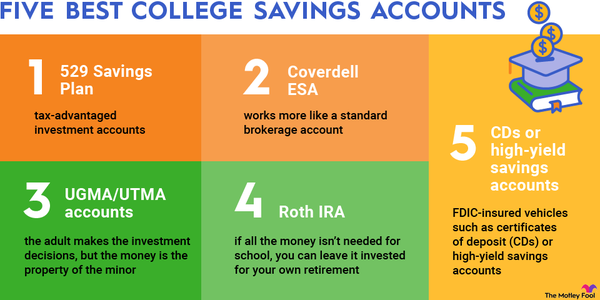With college costs getting more and more expensive, 529 plans are a great way for parents to save for their children's education. Almost all states operate 529 plans, but you don't need to pick your own state's plan. Many plans are open to residents of any state. This guide will cover the best 529 plans based on your goals and financial situation.

What is a 529 plan?
What is a 529 plan?
A 529 plan is a tax-advantaged account designed to pay for a beneficiary's education costs. The account owner, often but not always the beneficiary's parent, opens and funds the account. Contributions are made using after-tax dollars.
While originally solely for higher education, 529 plans can now be used for kindergarten through grade 12 costs, apprenticeship programs, and paying back student loans. There are two types of 529 plans:
- Education savings plans are investment accounts. Funds are used to invest in stocks and bonds, growing tax-free, and withdrawals are also tax-free when used for qualified education expenses. This is the most common type of 529 plan.
- Prepaid tuition plans allow you to purchase units at participating colleges in advance. You effectively lock in the current tuition.
Education savings plans are the far more flexible option. The beneficiary can use funds from an education savings plan for tuition and fees but also for books, other school supplies, meal plans, and room and board, including off-campus housing. With a prepaid tuition plan, the beneficiary can typically only use funds for tuition.
How to pick one
How to pick a 529 plan
The primary goal with a 529 plan is to save as much as possible for your beneficiary's college fund. There are several factors to look at to pick the right 529 plan:
- Tax benefits: Many states offer either tax deductions or tax credits to residents who contribute to their state's 529 plan.
- Investment options: Each 529 plan offers its own investment options. The best 529 plans will provide a variety of options to fit your goals and risk tolerance.
- Fees: Most 529 plans have an expense ratio -- a small percentage fee based on the amount of assets under management. Some also have other types of fees, such as annual maintenance fees.
- Type of plan: You may have the option of an education savings plan or a prepaid tuition plan. Education savings plans are normally preferable, but some parents like to lock in tuition rates.
Now, let's look at the top 529 plans for different situations.
529s for different situations
Best for Low Contribution: ScholarShare 529 College Savings Plan
If you're starting out with smaller contributions, we recommend California's ScholarShare 529 College Savings Plan. There's no minimum investment amount, and this plan is low on fees. It doesn't charge any sales fees, startup fees, or maintenance fees. You also don't need to be a California resident to open, contribute to, or use this plan.
All you pay is an annual asset-based fee, which depends on the beneficiary's enrollment year and the type of investment portfolio you choose. Annual fees currently range from just 0.04% to 0.43%.
Like other 529 plans, this plan has penalties if funds aren't used for qualified education expenses. These include a federal 10% tax penalty on earnings, as well as federal and state income taxes. Non-qualified withdrawals may also result in an additional 2.5% tax for California residents.
Best Affordable Option: Path2College 529 Plan
While there are several 529 plans that keep fees to a minimum, Georgia's Path2College 529 Plan is a standout here. Open to residents of any state, it offers a variety of options, including enrollment year and static investment portfolios.
All the portfolios have affordable fees. On enrollment year portfolios, annual fees range from 0.06% to 0.10%. Static investment portfolios have fees ranging from 0.08% to 0.12%. No matter what you choose, you won't need to pay much. If you want to invest in the stock market, a U.S. stock portfolio costs just 0.09% per year.
You can open a Path2College 529 Plan with a minimum of $25. The minimum contribution amount is also $25, but if you contribute through a direct payroll deposit with your employer, any amount is accepted.
Best for High Returns: Maryland College Investment Plan
The Maryland College Investment Plan is our top pick for high returns due both to the performance of its investment portfolios and a sizable state income tax break. Maryland taxpayers who pay into this plan can subtract up to $2,500 per beneficiary for contributions in that calendar year.
To make it even better, contributions of more than $2,500 per beneficiary can be subtracted for up to the next 10 years. For example, you contribute $27,500 to a Maryland Investment Plan in the first year. Even if you don't contribute anything else, you could subtract $2,500 per tax year for 11 years.
Since quite a few 529 plans have affordable options for the S&P 500 and other quality investments, tax breaks can make a big difference in which plan gets you the most bang for your buck. You may want to start with your state's 529 plan to see if it offers tax breaks for residents. While the Maryland College Investment Plan is great overall, it's best for people who live and pay taxes there.
Best for Diverse Investment Options: Bright Start
You'll have plenty to choose from with Illinois' Bright Start 529 plan. It provides investment options from more than 10 different fund families, including Vanguard and T. Rowe Price. You can choose from age-based, target, and individual fund portfolios and customize your plan based on your risk tolerance.
One of the advantages of Bright Start is that its age-based and target portfolios also have multifirm investment options available, allowing you to build a portfolio from different fund families.
Bright Start's portfolios offer solid performance with fees that are reasonable, although not the lowest you can find. The total asset-based expense ratio ranges from 0.06% to 0.765%.
Best for Wide Availability: Vanguard 529 Plan
The Vanguard 529 Plan is administered by the state of Nevada, but it's open to anyone, and it's a fantastic choice no matter where you live. Vanguard is known for low fees, and its 529 plan doesn't disappoint in that regard.
There are no enrollment fees, transfer fees, or commissions. Target enrollment portfolios have expense ratios of just 0.14%, while fees on individual portfolios range from 0.12% to 0.37%.
The Vanguard 529 Plan has an initial investment minimum of $1,000. For Nevada residents, the minimum is $500, which is still more than many 529 plans. However, you can open this plan with a $50 minimum if you open your account online and sign up for the automatic investment plan.
Best for High-Risk Tolerance: Oregon College Savings Plan
The Oregon College Savings Plan offers many portfolio options, and they all tend to perform well. We recommend it if you have a high risk tolerance because its aggressive target portfolio, in particular, has done better than similar offerings from other 529 plans.
This 529 plan charges a state administrative fee of 0.20% and variable asset-based fees of 0% to 0.453%, depending on the investment portfolio. For an aggressive target portfolio, total annual asset-based fees are 0.244%.
Anyone can invest in an Oregon College Savings Plan. However, you only get tax breaks on contributions if you're an Oregon resident.
Best Overall Option: Utah my529
For its consistent excellence, Utah my529 is the best of the best. It has earned Morningstar's Analyst Rating of Gold™, a rating few 529 plans receive, for 14 consecutive years.
Utah my529 gives parents plenty of portfolio choices. There are 12 target enrollment date portfolios, as well as static investment options. You also have the option of a customized portfolio.
As far as fees go, the asset-based fee range is 0.113% to 0.124% for target enrollment date portfolios, 0.090% to 0.200% for static portfolios, and 0.120% to 0.398% for customized investment options. It's not the cheapest option, but slightly higher fees are a small price to pay for top-notch performance from a well-managed 529 plan.
Related investing topics
Which 529 plan is right for you?
The right 529 plan for you will depend on what features you're looking for. Some 529 plans are great if you want low fees. Others offer a variety of investment options, and performance also varies from plan to plan. Start with the 529 plans on the list above, as well as your own state's plans, to see which is the best fit.
FAQ
529 plan FAQ
Which 529 has the best performance?
The Maryland College Investment Plan has the best five-year and 10-year performance among 529 plans, according to SavingForCollege.com.
What type of 529 account should I open?
An education savings plan is the most common type of 529 account, and it provides much more flexibility than a prepaid tuition plan.
Is a 529 plan better than a high-interest savings account?
A 529 plan can offer better returns than a high-interest savings account, because 529 plans allow you to invest your money and offer tax breaks.
What is the average rate for a 529?
Fees vary depending on the 529 plan and investment portfolio you choose, but they generally range from 0.10% to 0.70%.







